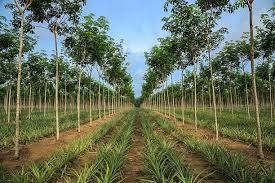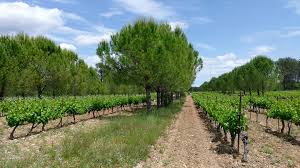You will realize that the maintenance of tree crop farms is an all year round activity. It embraces various operations at different periods of the year. If you give adequate field maintenance to your tree crops, you will discover that it helps to reduce the risks of weeds, disease and pest infestations.
This article will take you through the major items of post planting maintenance which are among other things, weeding, mulching, shade management, pruning and removal of lateral suckers, replacement of dead stands, pest and disease control.
Gapping Up of Tree Crop

Supplying of vacancies is usually done during the first two rainy seasons after planting of the new farm. This will give you a measure of uniformity among the tree. Supplying operations or gasping up is done as soon the rains become established.
Variation is climatic conditions that makes the recommendation of a specific time difficult, but the essential point is the adequate rainfall during and after the operation. Always carry out supplying operations well within rainy season to give the seedlings adequate rain for growth before the onset of dry season which may result in heavy losses.
You will realize later that the earlier the vacancies are filled the better are the chances of these seedlings catching up to give a uniform tree crop plantation. Supplementary irrigation, the filling of vacancies becomes less dependent on climatic factors.
Weed Control in A Tree Crop Plantation
To control weed effectively, you must remove the unwanted plants and shrubs from the orchard. Weeding is a great problem when fields are badly established, especially where cover crops are not properly established and, generally, the weed is greatest during the first four to five years, before the plants have established a close canopy.
Frequently weeding, type of weeding and use of herbicides vary with the type of crop. You may follow the following guide lines:
1. Plant plantain as a shade plant: You may wish to plant plantain as a shade plant but avoid planting bananas.
2. Keep the orchard weed free: You will have to supplement your three row weedings with at least four to six slashings of the foot paths in a year
3. Mulch the trees towards the end of the rains: You should grass mulch and avoid placing trash close to the base of the plants.
Retention of Moisture (Mulching)
This is the provision of a surface layer of dead vegetable matter to keep soil around the plants moist and enrich it with organic matter, apply this cultural method which yields great dividends when properly carried out. Application of mulch is important for the following reasons:
1. Mulch conserves moisture round the plant.
2. It helps to cool the soil around the plant
3. It supplied organic matter to the soil on decomposition
4. Mulch assist in controlling weeds around the plant and it acts as an anti- erosion measure.
If you add the advantages of mulching to those of other maintenance operations, growth of the crop is superior which results in more vigor, early canopy formation and early heavy yields.
Provide the plant with mulching with 15cm thick and covering an area from 15 cm to 1m away from the base of plant to discourage termites which might first attach the mulching material and then move to the seedling.
Vegetative mulching is preferred to synthetic much such as polythene sheets, because of high costs and also because the poly sheet does not add nutrients to the soil.
Read Also: How to know the Best Specie of Fish to Raise
Shade Management

Many tree crops in Nigeria originated as part of the under storey of the tropical forest and require shade during their first few years after planting in the field. The ideal shade plant should satisfy the following conditions;
1. It should be easy to establish
2. It should establish it to provide an evenly distributed shade within a short time of planting and throughout the year, especially during the dry season when shade is most needed.
3. It should compete as little as possible with the crops for soil nutrients and especially for moisture,
4. It should be so temporary that it will be easy to remove when no longer needed, and the process of its removal should do as little damage as possible to the crop.
5. It should not be an alternative host to insect pests and diseases of the crop.
It might be of interest to you to know that so far the ideal shade plant has not been identified for many tree crops in Nigeria, but plantain and not bananas is nearest to an acceptable shade plant. as you have been earlier informed above, natural shade is used, land preparation is done by felling or by selective thinning.
In addition to permanent shade, nurse shade is recommended for a few tree crops in Nigeria. Cocoyams (Colocasia esculentum) have been successfully removed after two or three years so that you do not have a situation when it becomes an active competitor for nutrients and moisture with the orchard crop.
Provide temporary shade in addition to various shade plants. This is generally necessary during the first dry seasons after planting into the field.
You can provide temporary shade through the use of palm fronds. You must remove temporary shade at the end of the dry season i.e when the early rain must have become established.
Importance of Pruning in A Tree Crop Plantation
You need to carry out pruning essentially to remove unwanted growth and thus maintain regularly shaped trees carrying a well-balanced, firmly closed canopy. Pruning is use sometimes to regenerate old trees. If your pruning is unskillful it may lead to unnecessary injuries to trees with consequent reduction in yield.
Remove unwanted vegetative parts (lateral suckers, chupons). These should be removed as close as possible to the stem from which they emerge preferably at an early age, to save the trees from wasting their energy on unwanted growth which may even affect there productive growth and development of the tree.
The removal of unwanted growth from the canopy and light pruning can be carried out at any time of the year to minimize effect of mutual shading. Heavy pruning, (formation pruning) which is aimed at regulating the shape of the trees, you may wish to carry out when the early rains become established.
Use a light-weight sharp cutlass or pruning saw, which are the most suitable tools for most pruning operations. Use a sharp knife or pair of secateors for removing chupons, lateral suckers, young flushes and major branches.
A heavy bow saw is recommended for removing branches and stems. Pruned surfaces should be painted with ordinary paints or any sealing compound to prevent disease infection.
Lateral suckers are generally profuse and troublesome in crops such as citrus and coffee. In citrus their prevalence, especially around the bud union is indicative of incompatibility between root stock and scion.
Read Also: The Most Lucrative between Production of Fish Fingerlings or Raising them to Table Size
Establishment and Management of Cover Crops

Leguminous plants such as cowpeas, centrosena pubescens are commonly used as cover crops in tree crop cultivation in Nigeria, at least for the first few years before canopy establishment.
The use of a cover crop is more popular with those three crops that are widely spaced. Guava, cashew and so on. The main advantages of leguminous cover crops in tree crop orchards are as follows:
1. The cover crop serves as an anti-erosion measure
2. It helps to suppress weed
3. It adds nitrogen to the soil through its nodules
adds organic matter to soil and help to cool the soil while the roots help to improve the physical structure of the soil
Establish cover crops as early as possible after hand preparation. If you had clear felled the land previously, it will be advisable to establish cover crops before planting the main crop.
When sample felling and selective thinning as earlier discussed is practiced, the cover crop can be established after field planting.
The management of the cover crop is as important as its establishment. Keep cover crops away from the crops by a space of at least 30-40cm around each plant.
The cover crop is to cover the interspaces between the plants. If you use a cover crop, it is not necessary for you to use non- selective herbicides. Improperly managed cover crops can turn out to be the most dangerous used weed in the plantation.
Water Supply (Watering/Irrigation)
If you establish your orchards or plantation in area where there is adequate rain fall for a greater part of the year watering or irrigation of tree crops in the field may not be necessary.
In many parts of Nigeria, the dry season may last up to three to six months. In such areas, as the Northern part of the country, success in the establishment of tree crops in the field will depend to a great extent on the supply of water to the seedlings during their first two dry seasons in the field.
Adequate mulching and establishment of cover crops helps to economize on the application of water. Carry out your watering during the cool hours of the day, preferably in the mornings or the evenings, and you should not allow water to collect around the seedlings in order to prevent water logging while could lead to diseases or even death of the seedlings.
Copping Patterns with Tree Crops
The normal practice with tree crops is sole cropping especially where land is abundantly available. However, land is gradually becoming limited in most free crop producing areas in Nigeria.
Also, many tree crops are widely spaced, and in the early years before these crops form their canopy, it has been shown that intercropping with compatible annual crops is an economic advantages.
When intercropping, you should leave a space of 1m to the tree crop seedling in the first year. You should gradually increase this distance in subsequent year until you stop intercropping when canopy closes in.
It is important that you adopt adequate fertilizer practices for the intercrop in addition to those for the tree crop.
This article has taken you through what is involved in post planting maintenance and services of a tree crop Orchard plantation.
Special attention must be paid to the following activities if a success must be made of maintenance of the field: gapping up; retention of moisture; known as mulching; weed control; shade management; pruning; establishment and management of cover crops; water supply and cropping patterns with Tree crops.
Do you have any questions, suggestions, or contributions? If so, please feel free to use the comment box below to share your thoughts. We also encourage you to kindly share this information with others who might benefit from it. Since we can’t reach everyone at once, we truly appreciate your help in spreading the word. Thank you so much for your support and for sharing!
Read Also: Succulent Plants: A Guide to Growing and Caring for These Unique Plants

